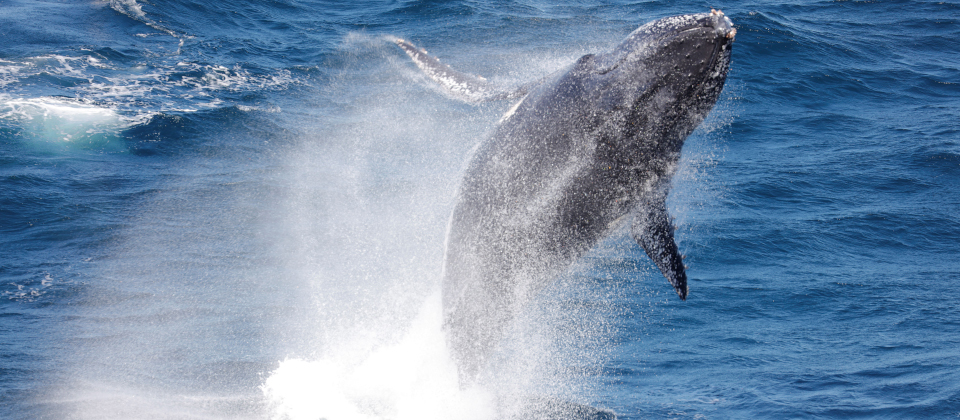Large numbers of Humpback whales observed off the southern Mozambique Coast

August 2023 – Scientists aboard the research vessel (R/V) Dr. Fridtjof Nansen observed unusually large numbers of whales in the waters off Mozambique, only a few hours after leaving the port of Maputo to study deep-sea species and habitats in the area. In total, dozens of pods with over 150 steaming Humpback whales were observed. This was a rare find according to Carlos Bento and Almeida Guissamulo, who both participated in the research survey with a role to study marine mammals and birds.
“I expected to see some pods, as whales have initiated their migration from the Antarctic, where the waters of the Southern Ocean have cooled down and the surface is freezing, to the warmer waters of the Southern Hemisphere, but this was spectacular!”, said Bento, who is a researcher at the Natural History Museum of Maputo alongside Guissamulo who is a fellow researcher and a senior Lecturer at the Department of Biological Sciences at the Eduardo Mondlane University.
Whales are fascinating species that play an important role in the ocean. They are top predators in the Southern Ocean, where they forage on krill (a pelagic crustacean), a fast-reproducing zooplankton species dominating the area.
They are helping reduce global warming, as it is estimated that each large specimen sequester an average of 33 tons of carbon dioxide from the seawater, allowing the ocean to absorb more carbon dioxide from the atmosphere.
The migration of whales to the tropical breeding grounds of the Mozambique channel is also a feeding opportunity for shark species that scavenge on whale carcasses, and an important tourist attraction.
When the R/V Dr. Fridtjof Nansen was in southern Mozambique earlier this winter, from 24 May to 24 June, no Humpback whales were observed. It was not until the vessel reached the northern section of the Sofala Bank, off the Zambezi River Delta and along the coast of the Zambezia Province, that 71 whales where seen.
A reason for not seeing any whales during the earlier survey could be the different migration routes, with one being the Central Mozambique channel, and the others being the eastern Africa route or the Madagascar ridge corridor.
“The whales we encountered in August are the ones that migrated along the eastern African route in the Mozambique channel, and they were probably the last ones leaving the Southern Ocean,” Bento explained, adding that the migration speed may also have been a factor. Still, the number of animals sighted was extraordinary.
Final counts indicate that there were 923 Humpback whales spotted over the course of three days, from the exit of Maputo Bay to the south of the Bazaruto Archipelago, excluding those that could not be registered during the night.
The observed number of whales' account to more than one percent of the total population of the southern Humpback whales that is estimated to 80 000 individuals by the IUCN, and that, in part, migrates to the Mozambican coast annually. The global population is estimated at around 135 000 individuals.
The observations made by Bento and Guissamulo, included the recording of several behaviours, such as courtship, breaching and other social behaviours. Some pods were dominated by females that were accompanied by juveniles and sometimes newborn calves.
“What we learned from observing the whales, is important for understanding the population of Humpback whales,” said Bento. Guissamulo, noted that the findings also resulted in several questions like: how far along the Mozambique channel do the whales migrate, how much time do they spend there, do they gather at the same places, and is it possible to estimate population trends?
Earlier studies from surveys carried out in 1991 and 2003 from Maputo to the coast of Zambesia and to Mozambique island respectively, resulted in the designation of the Mozambique coast as an Important Marine Mammal Area (IMMA), by the Marine Mammals Protected Area Task Force, mainly to protect breeding Humpback whales.
During the survey that lasted from 3 to 15 August, deep-sea and mesophotic reefs around the Bazaruto Archipelago and the central Mozambique continental shelf were in focus, to improve the understanding of the diversity and health of the marine environment. Yet, the study of marine animals and birds added value, contributing with data and information to build the knowledge base on Humpback whales and inform decision-makers to prevent their disturbance from current and emerging threats.
About the Programme
The R/V Dr. Fridtjof Nansen is at the centre of the EAF-Nansen Programme, a partnership between FAO and the Norwegian Agency for Development Cooperation (Norad), Norway’s Institute of Marine Research (IMR), and 32 partner countries in Africa and the Bay of Bengal.
While the current phase of the Programme is ending in 2023, plans are already underway for the future. From 2024 to 2028, there will be an increased focus on governance and the science-management policy nexus, supporting countries to achieve the Sustainable Development Goals and contributing to the objectives of ongoing initiatives such as the UN Decade of Ocean Science for Sustainable Development.
More on the topic:
